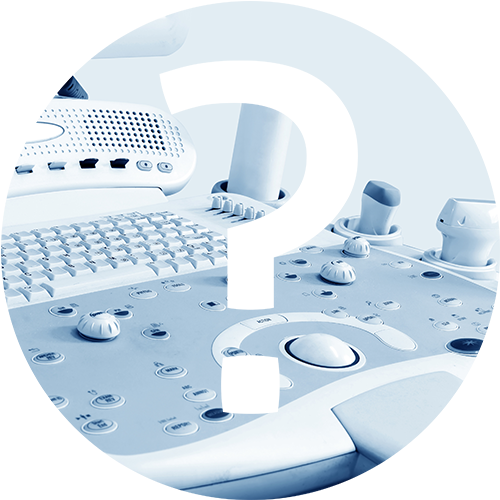Ultrasound is one of the least invasive and most widely used diagnostic medical tools available.
It transmits safe, non-invasive, ultra-high frequency sound waves and creates an image from the resulting echoes. These echoes are recorded, processed, and displayed on a screen by a computer.
When compared to other procedures, an ultrasound study generally involves no discomfort and requires very little patient preparation. Unlike X-ray, ultrasound does not require the use of radiation; it is used to study internal organs, such as the heart, liver, uterus, ovaries, blood vessels, and other soft tissue structures.


What Can You Expect During Your Ultrasound?
Before the exam, you will change into a gown. You will most likely be lying down on a table with a section of your body exposed for the test.
Our ultrasound technologist, called a Sonographer, will apply a special lubricating jelly to your skin. This prevents friction so they can rub the ultrasound transducer on your skin. The transducer has a similar appearance to a microphone. The jelly also helps transmit the sound waves.
The transducer sends high-frequency sound waves through your body. The waves echo as they hit a dense object, such as an organ or bone. Those echoes are then reflected back into a computer and form a picture that can be interpreted by the doctor.
Depending on the area being examined, you may need to change positions so the Sonographer can have better access.
A typical procedure lasts less than 30 minutes, depending on the area being examined. You will be free to go about your normal activities after the procedure is completed.
How to Make an Ultrasound Appointment?
Your physician will determine what type of ultrasound you will need and provide a prescription.
Please contact us and we will help to find the best location for your ultrasound.
888-265-8670
Once your appointment is scheduled, you will receive verification of your appointment time and location. You should arrive 20 minutes prior to your scheduled appointment in order to register.
Pelvic Floor
Therapy

What is Pelvic Floor Therapy?
This conservative, non-surgical therapy is used to treat incontinence, urgency, pelvic pain, or to re-educate the pelvic floor muscles to restore and maintain health.
Pelvic Floor Therapy is most commonly prescribed for the following disorders:
| Common Disorder | Benefits of Pelvic Floor Therapy |
|---|---|
| Urinary / Mix incontinence | Increases bladder control |
| Constipation | Improves regular bowel movements |
| Pelvic organ prolapse | Prevents future surgeries |
| Chronic pelvic pain | Strengthens pelvic floor muscles to reduce pain |
| Weakened muscles after child birth | Post-partum rehabilitation |
Pelvic Floor Muscle Exercise Therapy

Electrical Stimulation During Pelvic Floor Therapy

What to Expect During Pelvic Floor Therapy?
With each visit, you will consult with your Onsite healthcare professional about your progress and discuss your therapy regimen. Typically this therapy consists of weekly sessions for six to eight weeks. The first session will last about one hour while the remaining sessions will last about half an hour.
It’s a good idea to wear comfortable clothing to your therapy sessions, and if you use pads or absorbent products, please bring a replacement with you.
How to Make a Pelvic Floor Therapy Appointment?
Your physician will determine what type of Pelvic Floor Therapy you will need and provide a prescription.
Please contact us and we will help to find the best location for your pelvic floor therapy.
888-265-8670
Once testing or your initial therapy session is scheduled, you will receive verification of your appointment time and location. You should arrive 20 minutes prior to your scheduled appointment in order to register.





